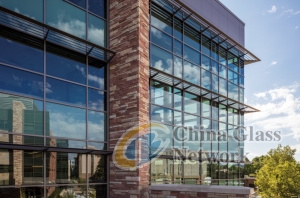Post Time:Sep 30,2021Classify:Industry NewsView:1222
When it comes to glassy facades, the spandrel area isn’t always the coolest feature. In fact, it’s usually quite the opposite. According to glass consultant and technical expert, Bill Lingnell, the spandrel area can get extremely hot. From his own measurements, he’s seen it as hot as 244 degrees. And on many projects, Lingnell points out the spandrel area can take up a significant portion of the façade.

The Colorado State University Biology Building in Fort Collins, Colo.,
uses glazing products from Guardian Glass to create a nearly seemless
aesthetic between the vision and spandrel glass areas.
“It can be an estimated 30 to 40% of the wall system when we consider floor-to-floor distances of roughly 12 to 13 feet and vision area windows nominally 7 to 8 feet tall,” he says.
So what if, instead of just holding on to that heat, the spandrel area became a more functional part of the building? It’s a question that several in the industry are pondering. Technologies that offer such potential are being developed, but are in their infancy. While the option is there, it could take some time before it reaches market acceptance.
Understanding Spandrel
For many multi-story buildings, spandrel glass has an important role to play. It’s there to hide the sections between floors where building components are held. Unlike the transparent vision glass portions of the facade, spandrel glass is opaque and typically coated with either a silicone-based paint or ceramic frit. It is most commonly tempered or heat-strengthened monolithic float glass. Insulating glass is also an option. The goal is to create an aesthetic that blends seamlessly with the vision glass.
While spandrel glass has an important job, it isn’t necessarily an architects’ first priority in the specs.
“They have to have [spandrel] to fill in areas between floors or columns or areas that they do not want people to see (i.e., vents, wires, slab ends and mechanical equipment),” says Lingnell.
Nathan McKenna, marketing and innovation manager with Vitro Architectural Glazing in Pittsburgh, says he does see architects putting a lot of thought into their spandrel selections.
“A lot of architects do put time into it with custom colors, for example,” he says. “Some just want the standard … but it’s on a project-to-project basis.”
Moving Forward
As building codes demand increasingly high performance, the glazing industry has responded, offering more efficient products. While most of these have been for the vision area, opportunities exist to also improve the spandrel area. The question is, how do we get there?
Kinder says the next steps for the future of glazing and advanced facades involve moving beyond the typical.
“What else can glass do for us?” he asks. “We’re finding that advance analysis and more modeling tools are becoming increasingly important for everyone in the supply chain. It’s always a matter of cost vs benefit, and the cost isn’t always just the installation cost, but also the payback cost.”
He continues, “People want glass. They want to put glass on the façade and they don’t want to reduce the glazing. [We will see] evolution in new products to boost thermal performance, especially in the northern climates.”
Looking at the advances glass has seen, Maikowski adds, “We have to find ways to keep up with the game in the codes and Europe is even more aggressive… the industry has to find ways to be innovative, whether that’s through BIPV or transparent PV, triple thin glazing or VIG … we’ve got to find a way to increase [performance] beyond passive low-E,” he says. “The opportunity is there, but it takes a leap of faith. Codes drove the adoption of low-E before and I think they will with new technologies, as well.”
Source: usgnn.comAuthor: shangyi
PrevAccelerating O-I Glass’ transformation
The Dorflinger Glass Factory Museum and a vanished industryNext